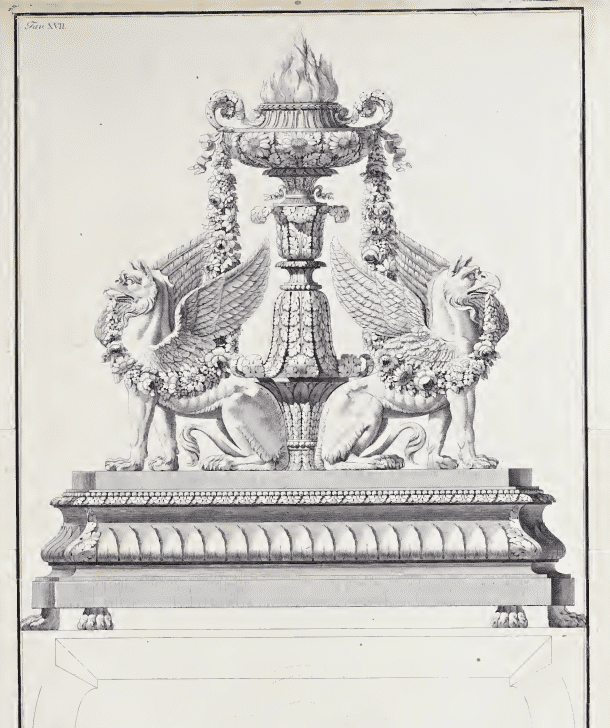- Commode with three drawers, G.B.M.
Four truncated pyramidal feet inlaid with architectural drips support the base on which the piece of furniture rests and from which the two tapered columns in partially dyed boxwood start. On the entablature that rests on the columns, under the marble top, there is a Greek “can current”. On the edges, as well as on the bottom of the sides, an architectural pilaster motif is proposed in inlay. On the sides, on a red wooden background, two plinths are inlaid on which two griffins rest and from which leafy volutes branch off. The front presents an articulated score of spaces, with three main reserves, of which the central one is superimposed by an almond-shaped reserve and then again by a rectangular one that contains the inlay reproduction of a print with a mythological subject in which Pan is depicted, the satyr, surrounded by some nymphs. The spaces are enriched with floral inlays and shells.
In the lateral reserves of the front, two opposing griffins are inlaid, resting on a plinth supported by three eagles, the two lions with eagle heads and wings, holding in their jaws two festoons that fall from a flaming candelabrum. Veneered in a wide variety of woods, the main ones are, the bottom in exotic red colored wood, unidentified, walnut, bois de rose, maple, olive, ebony, boxwood.
In the central reserve at the foot of the nymph there is the engraved signature, “G.B.M. February 8, 1804. Inven e desin tutto fecit ”. Roman marble top, veneered with flowery alabaster and with an antique green edge, certainly excavated marble, for a top made in the Baroque era and used for the furniture proposed here for the top. The writing, “FROM W. WILLIAMSON & SONS GUILDFORD” is stamped on the first drawer, traces of a passage of furniture on the English market in the late 1800s and early 1900s. Inside, the cabinet is built in walnut.
Dimensions: 94 x 123 x 62 cm
The piece of furniture described here is part of that typical early 19th century production to which the numerous shops opened by Giuseppe Maggiolini’s pupils turn and which imitate his production. In this case, however, we have an extraordinary piece of furniture, both for the choice of inlay motifs and for the ability to inventive at an architectural level, in the construction of the furniture and in the arrangement of the frets and reserves. All this suggests that for GBM it is a production that falls within that group of furnishings that are made by the workshop under the expert guidance of Agostino Gerli, as hypothesized by Giuseppe Beretti in the study article on monograms is G.B.M.
In this article, in addition to revealing Giovan Battista Maroni’s autograph, Beretti with a keen observation goes to show the collaboration between Gerli and the shop, for the production of Ajaccio and probably other orders. It is the international contacts of Agostino Gerli that allow not only foreign orders, but also to find Roman marbles.


The fact that the compositional presence of the furniture is dictated by the presence of an architect is quite evident in spite of the GBM signature. Some decorative elements derived from Giocondo Albertolli’s repertoire are chosen, among these undoubtedly the Greek a “can current (Giocondo Albertolli, Different ornaments invented by Giocondo Albertolli, 1782 Plate X) and, above all the design proposed in the two lateral reserves of the front (Giocondo Albertolli, Some decorations of noble rooms and other ornaments, plate XVII).
Not insignificant, at least to demonstrate the international success of this piece of furniture is the stamp placed on the first drawer by the London antique dealer.
– Giuseppe Beretti, Laboratorio, ed. In Limine, 2005;
– Giuseppe Beretti, Il monogrammista GBM ovvero Giovan Battista Maroni, www.laboratorioberetti.eu, 18 aprile 2019;
– Enrico Sala, Maggiolini & Co., ed. Anticonline, 2020.

FineArt is the new ambitious Di Mano in Mano project that offers an exclusive choice of antiques and design works, presenting them for their singularity and uniqueness.

FineArt by Di Mano in Mano is a team of experts at your service to enhance furniture, paintings, finest antiques, art and design masterpieces at best.
Di Mano in Mano
Via Castellazzo 8, Cambiago (MI)
20040